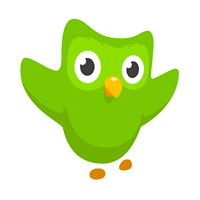
5 Chatbots for Practicing Conversational Skills in a Foreign Language
They interact like humans, but they’re not human.
We’re talking about “chatbots” or “bots,” which are computer programs that simulate real conversations.
Virtual reality language learning, language learning apps and, yes, language learning chatbots can now help you get your daily language practice and the language immersion you need from the comfort of your couch, bed or hyperbolic chamber.
Chatbots can even help you get the language conversation practice you need without a real human language exchange partner.
Contents
Download: This blog post is available as a convenient and portable PDF that you can take anywhere. Click here to get a copy. (Download)
Duolingo
Available: iOS
Cost: $30 a month for Duolingo Max
If you use any online language resources, chances are you’ve heard the name Duolingo once or twice (or more realistically, about a thousand times). There’s a good reason for that. It offers a free online resource and an awesome app designed to help you learn grammar and vocabulary through interactive spaced repetition.
But now, Duolingo has entered the chatbot game. Duolingo Bots use artificial intelligence to allow you to have life-like interactions. The Bots can work with thousands of potential responses, but if you hit a snag, you can also type “help me reply” for a little extra assistance.
Duolingo is working on adding new Bots, but currently you already have a nice selection. You might chat with pizza maker Chef Roberto, get directions from Renée the Driver or interact with Officer Ada.
You can access the Bots in the iOS app, and the conversation is a lot like texting a real person. Duolingo Bots will ask you questions, then you type your responses. From there, realistic conversations ensue on topics like what you want to drink.
While Duolingo does also have an Android app, the Bots aren’t yet available in this app.
The Bots are currently available for French, German and Spanish, with more languages on the way.
Memrise
Cost: Free to use
Up for an adventure? Memrise’s chatbots can launch into orbit.
Memrise is a learning program that uses the latest technology to help you hone your skills. This includes fun new chatbots.
Memrise’s chatbots are available in its apps. You can’t always get to them, but as you progress through the leveled learning, some chat options will appear. These chatbots focus on “missions” in outer space. While they employ useful vocabulary, they have an adventurous slant. To interact with the chatbots, you select words from a list to piece together sentences for a text-based conversation.
Memrise currently offers 20 languages, including popular languages like Arabic, Chinese, French, German, Italian, Japanese, Korean, Portuguese, Russian and Spanish, and some rarer choices like Icelandic and Mongolian.
Mondly
Cost: $9.99 a month for premium
Mondly is all about the latest technology. Not only do they offer chatbots, they also offer virtual reality, so you have plenty of engaging, immersive learning options with them.
You can access the chatbot easily through the main app interface. Unlike most other chatbots, the Mondly chatbot is voice-enabled. The chatbot will give you a prompt, and you’ll have a list of options for what you might say. Then, you speak into your device and the chatbot responds. Chatbot scenarios cover common activities, like greeting people and eating out, so Mondly’s chatbot is an easy way to improve your functional speaking skills.
Mondly offers over 30 languages, including standard options like Arabic, Chinese, French, German, Italian, Japanese, Korean, Portuguese, Russian and Spanish, and some harder-to-find options like Bulgarian, Indonesian, Persian, Thai and Vietnamese.
Eggbun Education
Cost: Free to download, $5.99 a month for premium
Eggbun Education is designed to help beginning language students practice their skills.
The artificial intelligence chatbot acts like a tutor. Lanny, as she’s called, focuses on providing you with guidance and direction in learning your target language. The interaction offers text-based dialogue along with audio examples. Along the way, Lanny will share information and ask you to type certain words to help you learn vocabulary and grammar.
Eggbun Education is offered for Chinese, Japanese and Korean.
Andy English Bot
Cost: Free to download, $6.99 a month premium
If you want to brush up on your English conversation skills, Andy could be a great option for you.
You’ll be able to practice day-to-day conversation topics such as talking about yourself and your interests, as well as more general topics such as the weather.
Additionally, you can also receive short daily grammar lessons that will improve your English understanding.
If there are any words you don’t understand that appear while you’re chatting, Andy can send you a definition and an example so that you can retain the new vocabulary. Andy can also correct mistakes you make while chatting.
A language learning chatbot may be just what you need to help your language skills finally reach the center of the maze that is your brain. After all, chatbots are becoming more complex, to the point that they can carry on thoughtful conversations or teach you new words.
You can take your chatbot practice several steps further by combining it with other resources for conversational language.
Social media platforms in your target language are great for picking up slang and casual expressions. Pair them with a translation app, and you’re good to go.
You can also combine chatbots with FluentU, a platform that helps you thoroughly learn the actual language used in authentic native content.
FluentU takes authentic videos—like music videos, movie trailers, news and inspiring talks—and turns them into personalized language learning lessons.
You can try FluentU for free for 2 weeks. Check out the website or download the iOS app or Android app.
P.S. Click here to take advantage of our current sale! (Expires at the end of this month.)
As technology gets more advanced and creative, there are more ways than ever to liven up your study routine. So go ahead and board the train to your next learning adventure!
Download: This blog post is available as a convenient and portable PDF that you can take anywhere. Click here to get a copy. (Download)
And One More Thing...
If you dig the idea of learning on your own time from the comfort of your smart device with real-life authentic language content, you'll love using FluentU.
With FluentU, you'll learn real languages—as they're spoken by native speakers. FluentU has a wide variety of videos as you can see here:
FluentU has interactive captions that let you tap on any word to see an image, definition, audio and useful examples. Now native language content is within reach with interactive transcripts.
Didn't catch something? Go back and listen again. Missed a word? Hover your mouse over the subtitles to instantly view definitions.
You can learn all the vocabulary in any video with FluentU's "learn mode." Swipe left or right to see more examples for the word you’re learning.
And FluentU always keeps track of vocabulary that you’re learning. It gives you extra practice with difficult words—and reminds you when it’s time to review what you’ve learned. You get a truly personalized experience.
Start using the FluentU website on your computer or tablet or, better yet, download the FluentU app from the iTunes or Google Play store. Click here to take advantage of our current sale! (Expires at the end of this month.)











